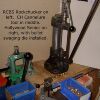Texasgrillchef
member
- Joined
- Jun 29, 2019
- Messages
- 700
Hypothetically speaking....
Many currently melt and mold their own lead projectiles.
lead melts at a lower temp then copper.
so wouldnt it he possible if someone made copper jackets and a mold, so one could insert the copper jacket with the base of the jacket that is open into the mold. Then pour the liquid lead into the jacket in the mold and thus make a copper jacket bullet?
Without all the pains and expense of trying to swage a copper jacketed projectile?
I looked into swaging and the cost and time is crazy! surely someone can think of a better easier less expensive way for us to make our own copper jacketed projectiles.
Many currently melt and mold their own lead projectiles.
lead melts at a lower temp then copper.
so wouldnt it he possible if someone made copper jackets and a mold, so one could insert the copper jacket with the base of the jacket that is open into the mold. Then pour the liquid lead into the jacket in the mold and thus make a copper jacket bullet?
Without all the pains and expense of trying to swage a copper jacketed projectile?
I looked into swaging and the cost and time is crazy! surely someone can think of a better easier less expensive way for us to make our own copper jacketed projectiles.

















